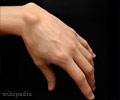Influences of micromechanical mismatch in cartilage regeneration have been studied by scientists for better joint transplants.

‘Micromechanical property mismatch is found to regulate proper cartilage regeneration and integration post-joint transplantation.’





Due to the limited blood supply and the small number of cartilage cells in the joints, it is difficult for the body to heal its damaged cartilage. Better Option for Cartilage Repair
Current treatments include grafting a patient’s intact cartilage from one joint to a damaged one, increasing blood flow to the damaged joint by making small holes in the bone beneath the affected cartilage), or transplanting a patient’s cartilage cells from one joint to another. Each of these methods is costly and does not adequately restore functionality to the damaged joint.A better option for cartilage repair involves the use of human mesenchymal stem cells (hMSCs), readily available cells which can renew and differentiate into various types of cells, including cartilage cells. With these cells, transplants can be engineered for more effective cartilage regeneration.
The joints of the body and their regulation of cartilage regeneration are exceedingly complex, influenced not only by chemical signals and external forces but by mechanical properties within the joint itself. Within the joints, the cartilage cells are surrounded by two distinct layers – the pericellular matrix (PCM) and extracellular matrix (ECM).
The PCM is a narrow, softer layer that closely surrounds the cartilage cells. The ECM is a stiffer layer surrounding the PCM that anchors and provides structural support to the cells.
Advertisement
If one is to engineer implants to replace damaged cartilage, therefore, these micromechanical properties must be re-created as closely as possible to drive proper cartilage regeneration and integration with the healthy native cartilage. One must also factor in the effects of external mechanical stresses on the implants, which can influence cell behavior.
Advertisement
Micromechanical Mismatch Properties for Better Transplant
The researchers examined these properties and their effects by creating innovative cartilage tissue equivalents as models of native cartilage. To create a PCM model, they employed microfluidic technology to create uniformly sized mini hydrogel droplets embedded with hMSCs. These mini hydrogels were then encapsulated by a stiff polymer layer which simulated the ECM.To simulate regular body movements upon the joints, the scientists used a chip that applied pressure on hMSC-laden PCM/ECM models with custom-engineered micromechanical property mismatches and measured the biomolecules produced.
From these experiments, the scientists were able to find optimal conditions for better cartilage regeneration while also reducing excessive cartilage formation.
These results were also demonstrated in animal models. The PCM/ECM tissue models were next implanted in mice, and when the external pressure was applied, the tissues’ micromechanical mismatch effects on cartilage formation were successfully maintained for three-week periods.
The scientists’ overall conclusions were that PCM stiffness and degradation and the micromechanical mismatch properties of the PCM-ECM work in synergy with cyclic mechanical compression to drive desirable cartilage formation in hMSCs.
Said TIBI Director and CEO Ali Khademhosseini, Ph.D., “With the various difficulties presented in cartilage repair, our scientists’ work in understanding the mechanisms that govern it is a much-needed step in successfully creating functional and regenerative cartilage tissue.”
Source-Eurekalert










